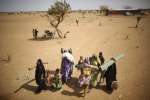- Text size
 |
|  |
|  |
| 
- Français
Central African Republic: UNHCR relocates Sudanese refugees away from volatile border
Briefing Notes, 16 November 2010
This is a summary of what was said by UNHCR spokesperson Andrej Mahecic – to whom quoted text may be attributed – at the press briefing, on 16 November 2010, at the Palais des Nations in Geneva.
In the Central African Republic, UNHCR and the CAR government began last week the relocation by air of some 3,500 Sudanese refugees from the camp at Sam Ouandja in the country's far northeast to Bambari region in the safer south-central part of the country. This refugee air-lift is taking place over approximately a month, with four daily rotations using 35-seater Dash-8 planes – larger planes simply can't land on the short Sam Ouandja airstrip. So far some 500 people have been moved.
Most of the refugees at Sam Ouandja originate from Dafak, a town some 200 kilometers away in Sudan's southern Darfur. They fled on foot in June 2007 to escape fighting and have been at Sam Ouandja ever since, but in conditions that over the past two years have become increasingly difficult.
Two main and related factors have made the move necessary. The first is insecurity. Sam Ouandja lies just 80 kilometers from the border with Darfur in an area with almost no government presence – the camp has found itself being frequently visited by fighters. The presence of armed bandits and rebels, and the withdrawal of MINURCAT, the UN peace-keeping mission securing the camp, are further reasons for the move.
Secondly, UNHCR faces extreme logistical difficulties in monitoring and assisting refugees in this remote part of CAR. Poor road conditions have limited our ability to transport aid to the camp. Instead of monthly distributions – the food and aid has been delivered every two or three months. During the rainy season, it takes, on average, some ten days for the trucks loaded with aid to cover some 950 kilometres between Bangui and Sam Ouandja.
The new camp lies just outside Bambari, where we have recently opened an office. Bambari is itself some five-hour drive (380 kilometers) north east from the capital Bangui and is significantly more accessible. The camp has ample capacity for the people being moved there. On arrival refugees stay at the transit centre for five days while constructing new family shelters with the kits we provide.
In CAR, UNHCR helps protect and assist some 25,000 Congolese, Chadian and Sudanese refugees and another 192,000 internally displaced persons. The three main groups of concern to us are IDPs in the north and in Haut-Mbomou; the Sudanese refugees now being moved from Sam Ouandja; and refugees in urban areas and Haut-Mbomou.























































